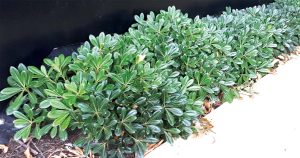Thousands of animals face a cruel death entangled on barbed wire fencing each year. Many nocturnal animals like bats, gliders and owls fail to see the fence or cannot clear the height in windy conditions.
Over 75 wildlife species have been recorded as fence victims, most caught on the top strand. Even Kookaburras in daylight get entangled in barbed wire. Wildlife needs to move freely and safely across our landscape unless being purposely excluded for safety and other reasons.
DESIGNING FRIENDLY FENCES
Do you really need a fence? How will a fence affect the wildlife?
If there are no animals to keep in or out, could a line of native trees do the job?
Avoid barbed wire.
When fencing livestock, consider using a combination of plain wire and electric fencing. Leave a gap at the bottom of the fence for small animals like Echidnas, Turtles and Bandicoots. Many native animals use scent trails or traditional routes to move from feeding grounds and mating sites, and if blocked by a fence, they can easily become lost.
To reduce the risk to wildlife, avoid placing barbed wire fences on ridge lines, near feed trees, across wildlife corridors, over or near water bodies.
TO REMEDY AN EXISTING HOTSPOT:
replace barbs with plain wire
cover barbs with split polypipe
make the fence more visible.
INCREASE VISIBILITY
Wire gates are often hard to see and dangerous to humans and wildlife. A way to improve visibility is to use white nylon sighter wires or white electric fence tapes that flicker in the breeze.
Do not approach a trapped animal as it is likely to struggle and do more damage. Where possible, leave the rescue to an experienced carer who will untangle the animal with minimal further injury. Do not handle flying-foxes.
For more information, contact Nick on 9653 2056, www.stillcreeklandcare.com.au email [email protected] or Facebook.
Table of Contents
Toggle










